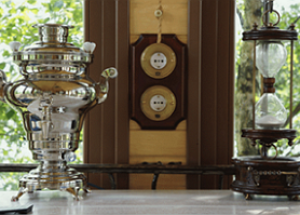The most important issue in the construction of the house is a well-organized distribution grid, which requires an informed choice of the type of electrical wiring. It will take a long and tedious collection of information scattered by various sources on the methods of installation. Useful tips will help evaluate the merits and demerits of Open wiring.
Content
Open wiring, in which cases
It is known that most builders prefer a closed type of electrical wiring, considering this option aesthetic. However, if you need to replace the electrical cable or repair the wiring, you will have to open and destroy part of the wall or ceiling.
Another thing is when there is an open wiring, the design of which is now in a high trend.
It is recommended to use an open type of wiring if it is not possible to enter a branch from the air main line of a self-supporting insulated wire (SIP) wire directly into the house.
According to the PUE for open wiring it is allowed to lay wires along the walls and ceiling of the house, in special electrical skirting boards, ducts and pipes fixed and mounted directly on the wall.
Helpful Tips
Indisputable dignity open wiring is a simple installation without strobilieniya walls. This is especially true when creating a wiring in a wooden house or in an interior of an old building due to the ignorance of the location of the existing hidden wiring when replacing. However, certain requirements are imposed on the open type of wiring.
What are the requirements for open wiring
The installation and installation of open wiring are subject to certain requirements, namely:
- wiring is recommended to be mounted on the work surface, by free suspension method, using strings, insulators, rollers and cables
- use a secure pipeline, depending on the location, to create a line, can be flexible or rigid
- the conductors of the cable must be connected in special boxes and paddles manufactured industrially from non-flammable material
- eliminate the location of cable channels in the vicinity of heat radiators and under conduits with condensation.
Requirements apply to all elements of external and internal open wiring.
elements of open electrical wiring
We call the posting elements:
- wires
- insulators
- piercing boxes.
The combination of correctly selected wiring elements determines the installation methods.
Helpful Tips
Selection wire material must match the type of room and work surface. We will suggest that for dry and damp rooms with brick or plastered walls it is recommended to choose the brand of the APV wire, APPV and APRN, APRI. To create a wiring on wooden walls, use the wire of APRF, APRN and APPR for dry premises, for humid - APRN and APPR. For wet rooms the wire is APV and APPV.
The self-assembly of the hooding box is to place its hull and fix it with self-tapping screws, and also to switch wires according to the marking.
Ways of installation of open electrical wiring
The following installation methods should be distinguished:
- flat wire on a wall or ceiling surface
- flat or twisted wire for rollers
- embedded wire in the corrugation or pipe.
Ways to install flat and twisted wires on rollers or over the surface require a preliminary sketch and presentation, as it will really look like. This is the main flaw open electrical wiring, as well, and simple access of children to the electrical wires, because you will not rewrite the wiring again!
flat cable installation
The installation is possible using a flat cable equipped with a separation base and without a base. A fixing insulation lock is prepared for the separating base.
The groove of the separation base of the wire is cut and the veins are cut at the cut site. Then the wire is fixed to the roller by placing two strips under the screw - a cardboard and metal buckle. The formed lock from above is fixed by a ring. By the way, this method of metal lock allows you to fix the wires in the landing hole on any surfaces.
installation of a twisted wire for rollers insulators
Installation of the wiring with a twisted wire creates a more attractive appearance (retro-wiring). Twisted wires and flexible cords make it possible to bend or twist them when laying the line. It is enough to tie the wire to the corner rollers and form a line taking into account the distance between the outer rollers 700-800 mm. The distance to the junction boxes must be 50-100 mm. It is necessary and necessary to place rollers for flexible wire in the places of circumvention of communications and in branching places.
mounting in metal corrugation, pipe or cable duct
More interesting and practical, from the point of view of the subsequent operation, is the installation of a wiring harness wire in metal corrugation, pipe or plastic cable duct.
The wires placed inside the channel are in a protected state.
Special auxiliary mounting supports: cable couplings, T-branches and tees, by fixing to the plane of the wall or ceiling improves installation of the wiring extremely easily.
Stages of installation
Basic stages of installation:
- Marking of the surface under the attachment points
- Drilling of fixing holes and installation of dowels
- Fastening the receptacle or box in place
- Mounting the device and cleaning the wires for subsequent connection.
How to do it yourself, shown here.
Video: Installation of open wiring.
































